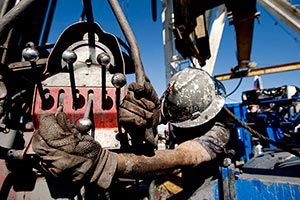Oil Seen Stuck in $50 to $60 Range as Shale Blunts OPEC Action

The world should get used to oil prices between $50 and $60 a barrel as falling costs in America’s shale fields counteract OPEC’s renewed commitment to supply management.
That’s the consensus among executives, traders and officials gathered at the annual Oil and Money conference in London. A prolonged period of crude trading in that range would signal that while the worst has passed for the global industry, there’ll be more financial pain ahead for oil-exporting countries and subdued profits at the largest energy companies.
The price outlook was reinforced in an unusually open speech by a board member of state monopoly Saudi Aramco, where he suggested the world’s biggest oil exporter doesn’t expect prices to rally much further before the end of the decade.
“A $50, $60 oil price — absent a supply accident — is sufficient to develop the low-cost resources to provide increases that will be necessary over the next three to four years,” said Andrew Gould, board director at state-owned Saudi Arabian Oil Co.
Others were equally skeptical about the prospect of markedly higher prices. The decision to rein in production by members of the Organization of Petroleum Exporting Countries at an Algiers meeting last month succeeded in pushing prices above $50 a barrel, but a sustained rally will be held back by the return of shale oil production from fields previously rendered unprofitable by the two-year slump in crude, the head of the International Energy Agency said.
“This upward pressure on the prices would stimulate some high-cost producers to increase their production, such as the U.S. shale oil,” Fatih Birol said Oct. 18 in an interview at the conference venue in London. “The price level around $60 would give a strong impetus to the bulk of the current U.S. shale industry.
The bosses of three of the largest oil traders — Vitol Group, Gunvor Group Ltd. and Mercuria Energy Group Ltd. — forecast prices would be between $55 and $58 a barrel in a year’s time.
That will offer precious little respite to economies under pressure from lower prices. Saudi Arabia, which relies on income from crude to fund public expenditures, has cut wages and spending to reduce a budget shortfall that grew to 15% of economic output last year, the widest since 1991. It needs oil to be well above $60 a barrel to balance the budget. Fellow OPEC member Venezuela has seen its finances decimated by oil’s collapse, leaving the government struggling to find enough hard currency for imports of basic necessities.
Oil companies, too, have been battered by the market rout. Exxon Mobil Corp., Chevron Corp. and BP all posted lower profits in the second quarter, while some smaller producers have been forced out of business altogether. While producers have cut costs, most still need oil well above $50 to meet spending commitments and pay dividends to investors.
The industry got “too big” and spent too much, BP CEO Bob Dudley said at the conference, and the company now only invests in the “best projects." Hess Corp.’s John Hess said producers need as much as $80 a barrel for “long-cycle” developments.
Ryan Lance, the CEO of ConocoPhillips, emphasized how successfully some U.S. shale fields had reduced their break-even levels. New wells in parts of the Permian, Bakken and Eagleford areas are now profitable at $40 a barrel.
He made clear that the only response to today’s market outlook was to keep cutting costs: his company was working to break even at less than $50 a barrel.



